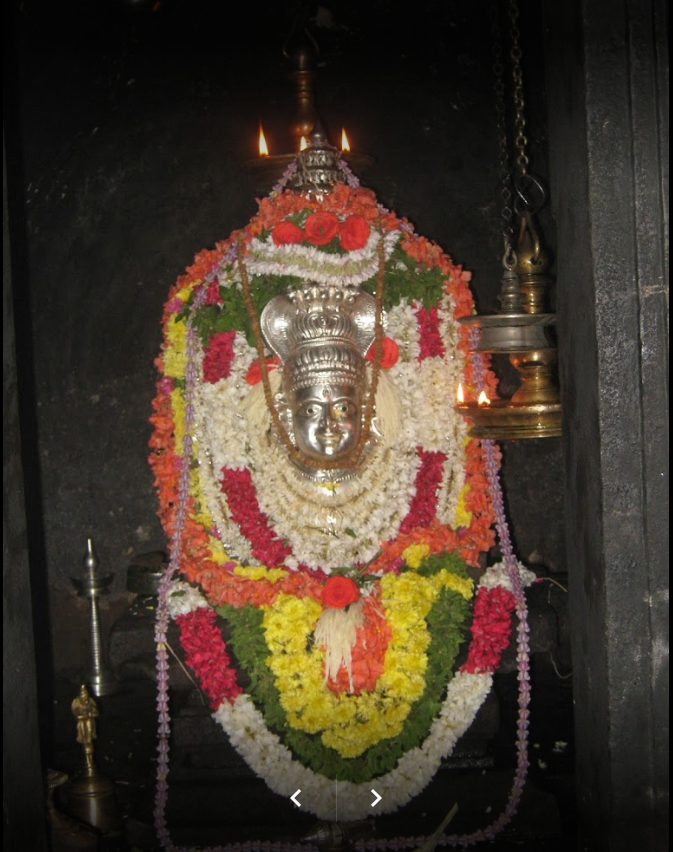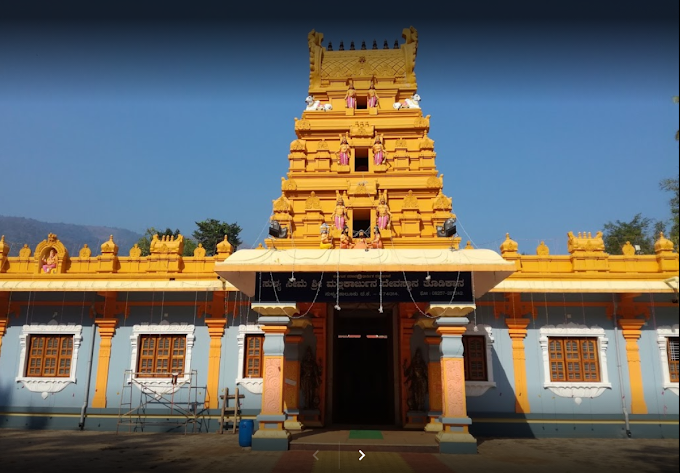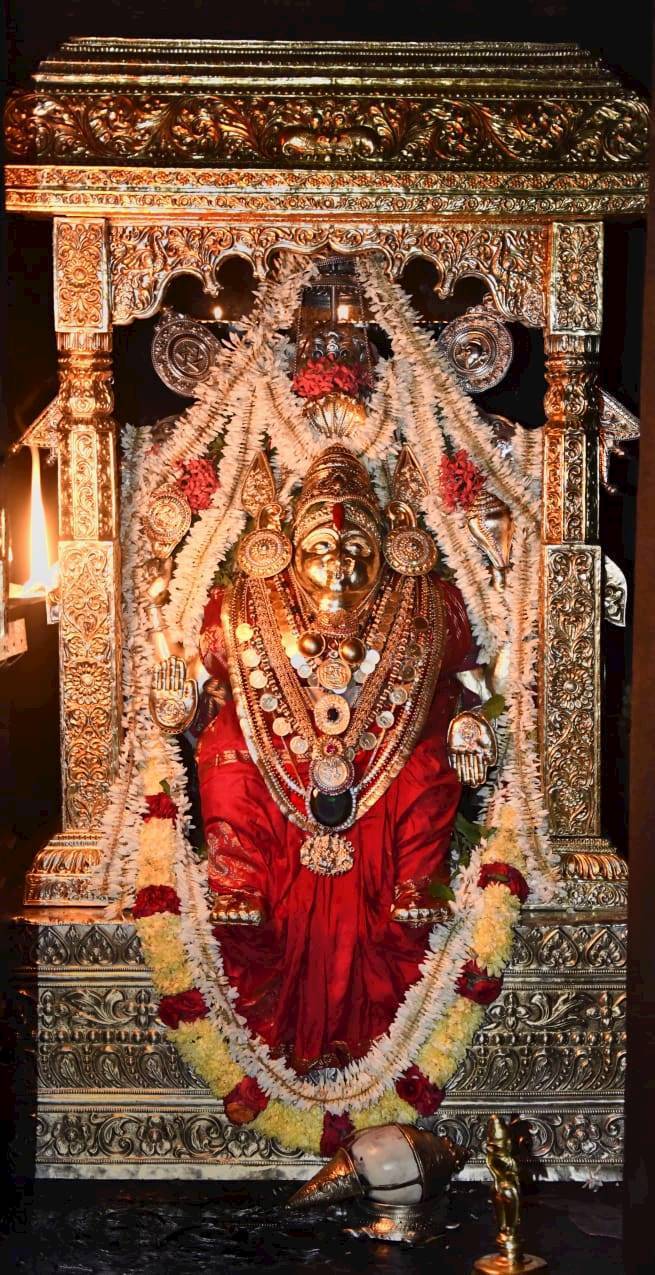About
In the later part of the 18 century a handful of G.S.Bs were reportedly staying in Kasaragod town. There was no temple or place of worship for them and they used to visit Manjeshwara for the same. Then it dawned upon them to have a temple of their own to conduct religious, social and cultural activities.
The prominent among the community, Pattanashetty. Santhappa Shanbhogue and Purohit Vedamoorty Anantha Padmanabha Bhat joined hands to form a committee of 'Tens' of the town. A mutt with thatched roof was constructed in the northern side of the present temple site and an idol Sri Kodandarama was consecrated on an auspicious day in 1772. The math became a center for the G.S.Bs in the town not only to worship but also to conduct cultural activities and to have social gatherings
As the temple achieved all round development, in course of time, the G.S.B community felt that Temple should not only be renovated completely but also to have all the essentials of a Temple such as Amrithapadi, Nandadeepa etc, once the presiding deity is reinstalled (Punarprathishta) with all the vedic rites and rituals.
The Tens' of the community called for a meeting presided over by Pattannashetty Krishnayya and his brother Ananthayya and attended by prominent G.S.B. members of that time.
The Pattanshetty family volunteered to construct the Sanctum Sanctorum of the proposed temple and rest of the community members offered financial and labour help to construct a Chathu Soothra Ambala (a four cornered temple structure.). Accordingly it was built in 1798 On Phalguna shuddha Bidige of Siddharha Samvatsara the presiding deity was consecrated with all the formalities and gaiety.
In 1905, about a century ago, revered Srimad Sri Varadendra Teertha Swamiji, the then pontiff of Shree Kashi Math Samsthan installed the presiding diety of Sri Varadaraja Venkataramana exactly at same place where we see the Sanctum Sanctorum and the idol of Sri Padmavathi Devi at the outer south east corner of the Sanctum Sanctorum. The auspicious occasion was held on Chaitra Poornima of Vishwavasu samvatsara. At that time there were about 80 G.S.B households with about 700 members in the town.
In 1910, the Sankeerthana Bhajana Saptaha got a serene beginning with the installation of Sri Vittobha Rukumai idols.
There was also an urgent need for a Agrashala.With the Blessings of the revered Swamiji the committee so formed was able to raise the required funds and accomplish this task satisfactorily. A single storey building came up along with the Agrashala and it was befittingly named Shri Sukrateendra Mandir.
In 1943 the naivedya well inside the Temple premises and a wooden Lalaki was built. The community members in 1946 liberally donated for the construction of Sri Venkatesha Mandir, a gopuram on the eastern side of the Temple.
The prominent among the community, Pattanashetty. Santhappa Shanbhogue and Purohit Vedamoorty Anantha Padmanabha Bhat joined hands to form a committee of 'Tens' of the town. A mutt with thatched roof was constructed in the northern side of the present temple site and an idol Sri Kodandarama was consecrated on an auspicious day in 1772. The math became a center for the G.S.Bs in the town not only to worship but also to conduct cultural activities and to have social gatherings
As the temple achieved all round development, in course of time, the G.S.B community felt that Temple should not only be renovated completely but also to have all the essentials of a Temple such as Amrithapadi, Nandadeepa etc, once the presiding deity is reinstalled (Punarprathishta) with all the vedic rites and rituals.
The Tens' of the community called for a meeting presided over by Pattannashetty Krishnayya and his brother Ananthayya and attended by prominent G.S.B. members of that time.
The Pattanshetty family volunteered to construct the Sanctum Sanctorum of the proposed temple and rest of the community members offered financial and labour help to construct a Chathu Soothra Ambala (a four cornered temple structure.). Accordingly it was built in 1798 On Phalguna shuddha Bidige of Siddharha Samvatsara the presiding deity was consecrated with all the formalities and gaiety.
In 1905, about a century ago, revered Srimad Sri Varadendra Teertha Swamiji, the then pontiff of Shree Kashi Math Samsthan installed the presiding diety of Sri Varadaraja Venkataramana exactly at same place where we see the Sanctum Sanctorum and the idol of Sri Padmavathi Devi at the outer south east corner of the Sanctum Sanctorum. The auspicious occasion was held on Chaitra Poornima of Vishwavasu samvatsara. At that time there were about 80 G.S.B households with about 700 members in the town.
In 1910, the Sankeerthana Bhajana Saptaha got a serene beginning with the installation of Sri Vittobha Rukumai idols.
There was also an urgent need for a Agrashala.With the Blessings of the revered Swamiji the committee so formed was able to raise the required funds and accomplish this task satisfactorily. A single storey building came up along with the Agrashala and it was befittingly named Shri Sukrateendra Mandir.
In 1943 the naivedya well inside the Temple premises and a wooden Lalaki was built. The community members in 1946 liberally donated for the construction of Sri Venkatesha Mandir, a gopuram on the eastern side of the Temple.
On 17-2-1954 H.H. Shrimad Shree Sudheendra Teertha Swamiji presided over the committee meeting of the 'Tens' of the Kasaragod to formulate the programme for Punarpratishta of the presiding deity and Parivara Devas. Apart from the complete construction of the Sanctum Sanctorum with the Chathu Sootra Ambala , separate pooja room for the revered Swamijis exclusive use was also constructed. The Sthana parivartana for the reinstallation ceremony was conducted on 29-3-1954, Phalguna Bahula Navami of Vijaya Samvatsara. Subsequently on 8-4-1954 on completion of the preliminary formalities the Punarprathishta was held at the holy hands of Shrimad Shree Sudheendra Teertha Swamiji followed by installation of the Parivar devas with all vedic rites and gaiety. A casket of 90 tolas of silver was presented to the Lord by Rev. Swamiji to mark the occasion.
In 1957 The Gopuram in front of the Temple was reconstructed with a new single storey building which stands even to this day. The Gopuram on the southern side was also constructed simultaneously.
Sri Kaup Vaman Shenoy had an ambition to conduct a 52 crore Sri Rama Nama likhit japa yajna (Om Sri Ram Jai Ram Jai Jai Ram) to coincide with the golden jubilee celebration of Sankeerthana Saptaha. The request was placed before revered Srimad Shree Sudheendra Teertha Swamiji for blessings and guidance. Revered Swamier were thinking of such a religious event as ordained to them when they were camping at Basrur and as such were very much pleased. The Yajna was held from 20-4-1961 to25-4-1961 .Over 25000 devotees from all over the country attended the function. Without the aid of the present day mode of transport and means of communication the Yajna was organized with meticulous details and it was planned and organized for the first time in the history of the temple. The event was unique as even today the elders who attended the function still cherish the memory with awe.
After considering the 'prashna' on 21-4-1990 entire building was renovated .
The centenary building was constructed at Karandakkad Junction.
The celebration of the Diamond jubilee year of Sanyas Deeksha of H.H Shrimad Shree Sudheendra Teertha Swamiji began on 2-June-2003 in our Temple.
The momentum for the celebration of the centenary of the Prathishta of the lord was imbibed with the celebrations of Purushothama Masa in July-August 2004 with many vedic rituals and the tempo of propitiating the Lord for his benevolence was formed by organizing monthly religious rituals at the Temple round the Year.
On the eastern side of the Temple an auditorium was built named Shree Varadendra Kala Mandir.
Once in 3 or 4 years when need arises, Samoohika Upanayana will be performed.
In 1957 The Gopuram in front of the Temple was reconstructed with a new single storey building which stands even to this day. The Gopuram on the southern side was also constructed simultaneously.
Sri Kaup Vaman Shenoy had an ambition to conduct a 52 crore Sri Rama Nama likhit japa yajna (Om Sri Ram Jai Ram Jai Jai Ram) to coincide with the golden jubilee celebration of Sankeerthana Saptaha. The request was placed before revered Srimad Shree Sudheendra Teertha Swamiji for blessings and guidance. Revered Swamier were thinking of such a religious event as ordained to them when they were camping at Basrur and as such were very much pleased. The Yajna was held from 20-4-1961 to25-4-1961 .Over 25000 devotees from all over the country attended the function. Without the aid of the present day mode of transport and means of communication the Yajna was organized with meticulous details and it was planned and organized for the first time in the history of the temple. The event was unique as even today the elders who attended the function still cherish the memory with awe.
After considering the 'prashna' on 21-4-1990 entire building was renovated .
The centenary building was constructed at Karandakkad Junction.
The celebration of the Diamond jubilee year of Sanyas Deeksha of H.H Shrimad Shree Sudheendra Teertha Swamiji began on 2-June-2003 in our Temple.
The momentum for the celebration of the centenary of the Prathishta of the lord was imbibed with the celebrations of Purushothama Masa in July-August 2004 with many vedic rituals and the tempo of propitiating the Lord for his benevolence was formed by organizing monthly religious rituals at the Temple round the Year.
On the eastern side of the Temple an auditorium was built named Shree Varadendra Kala Mandir.
Once in 3 or 4 years when need arises, Samoohika Upanayana will be performed.
Contact
SHREE VARADARAJA VENKATARAMANA TEMPLE
RAILWAY STATION ROAD
KASARAGOD-671121,KERALA,
PHONE:04994-221422
MANAGER : GOPALAKRISHNA BHAKTHA (MOBILE: 9400422248)















